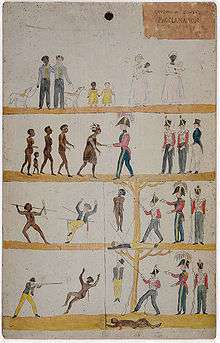Governor Davey's Proclamation
Governor Davey's Proclamation is a misnomer for an illustrated proclamation issued in Tasmania by the British government after the 1st November 1828. Although attributed to Governor Davey it was first authorised by Lieutenant Governor George Arthur.[1] Several illustrated narrative versions of the proclamation were created over time.[2] Many of these four-strip pictograms[3] were originally painted onto Huon pine boards using oil paints.[4] Of approximately 100 proclamation boards produced there are seven known to survive in public collections.[5]

The proclamation was intended to explain martial law during the period referred to as the Black War.[7]
Design
The pictogram scenes that depict Aborigines, British military and settlers were based on drawings by surveyor and artist George Frankland, who suggested in a letter to Governor Arthur that they be tied to trees in remote areas of the island.[8][9] The proclamation boards were designed to communicate to the Indigenous peoples of Van Diemen's Land that all people, black and white, would be treated equally under the British colonists law.[3] Historian Penelope Edmonds notes "The boards were made after the 1829 declaration of martial law against Tasmania's Aboriginal people, and the hangings from trees actually depict moments of summary justice and retribution on a violent frontier."[10]
The proclamation boards were reproduced by convict artists.[11] The drawing was mass-produced by pricking the outline of a drawing with a pin, in a technique known as pouncing or spolvero.[11] Charcoal was then dusted through the pinholes and pounded to make an outline.[11]
Distribution
The editor reported in the Hobart newspaper on 5 March 1830 that "We are informed that the Government have given directions for the painting of a large number of pictures to be placed in the bush for the contemplation of the Aboriginal inhabitants." [12][11]
Derivative images
A ceramic cup made by Tasmanian potter Violet Mace in 1934 is sometimes described as the 'proclamation cup' as it is hand-painted with a series of images that are derivative of those found on the proclamation boards. The cup is held in the collection of the National Museum of Australia.[10][13]
References
- ↑ Arthur, George. "A Proclamation". Sir George Arthur papers regarding Aborigines 1821-1837. State Library NSW. Retrieved 13 March 2013.
- ↑ "Governor Davey's Proclamation". Trove. National Library of Australia. Retrieved 14 March 2013.
- 1 2 Franks, Rachel (2015). "A True Crime Tale: Re-imagining Governor Arthur's Proclamation to the Aborigines". M/C Journal of Media and Culture. 18 (6). Retrieved 18 January 2016.
- ↑ Morris, John (1988-08), "Notes on A Message to the Tasmanian Aborigines in 1829: popularly called "Governor Davey's Proclamation to the Aborigines, 1816"", Australiana, 10 (3): 84–87, retrieved 8 July 2013 Check date values in:
|date=(help) - ↑ Gall, Jennifer (2011). Library of Dreams: Treasures from the National Library of Australia. Canberra: National Library of Australia. p. 58. ISBN 9780642277022.
- ↑ "Governor Davey's (sic) Proclamation to the Aborigines, 1816 (sic)". State Library of NSW. Retrieved 6 March 2013.
- ↑ Manderson, Desmond (2012/13). "The Law of the Image and the Image of the Law: Colonial representations of the rule of law" (PDF). New York Law School Law Review. 57: 154. Retrieved 13 March 2013. Check date values in:
|date=(help) - ↑ Kerr, Joan; Glover, Margaret. "George Frankland". Design and Art Australia Online. Retrieved 13 March 2013.
- ↑ Edmonds, Penelope (June 2011). ""Failing in every endeavour to conciliate": Governor Arthur's Proclamation Boards to the Aborigines, Australian conciliation narratives and their transnational connections". Journal of Australian Studies. 35 (2): 201–218. doi:10.1080/14443058.2011.562227.
- 1 2 Edmonds, Penelope. "The proclamation cup Tasmanian potter Violet Mace and colonial quotations". reCollections: a journal of museums and collections. 5 (2). ISSN 1833-4946. Retrieved 20 February 2014.
- 1 2 3 4 La, Khadija Carroll (2014), Art in the time of colony, Ashgate Publishing, ISBN 978-1-4094-5596-7
- ↑ "COLONIA TIMES". Colonial Times. 15, (722). Tasmania, Australia. 5 March 1830. p. 2. Retrieved 23 May 2016 – via National Library of Australia.
- ↑ "Mug depicting Governor Davey's Proclamation to the Aborigines of Tasmania 1816". Catalogue. National Museum of Australia. Retrieved 20 February 2014.
External links
- Aboriginal Proclamation, State Library of NSW 100 Objects Exhibition 2010.
- Governor Arthur's Proclamation, National Treasures, National Library of Australia.
- Governor Arthur's Proclamation board, Education at the National Museum of Australia.
- Syllabus bites Exploring a Source, NSW Curriculum and Learning Innovation Centre.